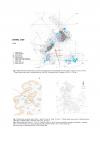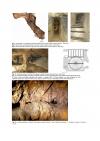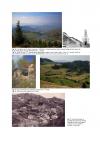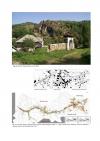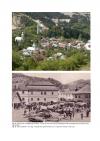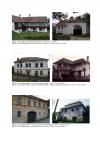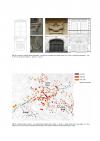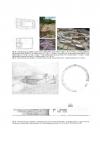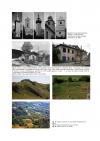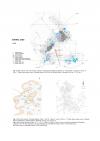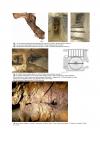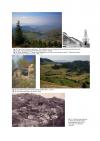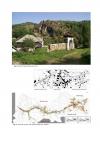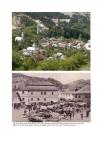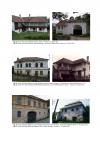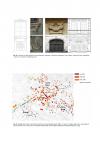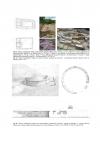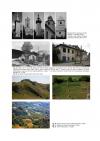Background Note regarding the universal value of The Historic Site of Roşia Montană
Roşia Montană Mining Landscape
Category: cultural landscape
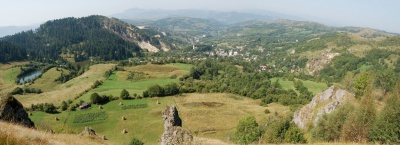
Description
Roşia Montană - Alburnus Maior - Rubeo Flumine - Verespatak - Rotbach - Roşia de Munte - is situated in the Metalliferous Mountains, part of Apuseni Mountains, the Western section of Romania's Carpathians (fig. 1), in the area named the Golden Quadrilateral (Cadrilaterul Aurifer) (fig. 2) - a territory rich in deposits of precious metals, known and exploited since antiquity. Of all the known historic exploitation points, the site of Roşia Montană is characterised by an exceptional concentration of cultural heritage values that are grouped in a configuration with a rich temporal and physical stratification, defined by the dense layering of vestiges belonging to Roman, medieval, modern and present-day mining (fig. 3).
Those pertinent elements, relevant for the universal value of the site are presented hereby.
The historic development of the site can be followed starting from the deepest level - which is represented by mining galleries, air shafts and water channelling systems, including spectacular drainage systems, carved within four mountainous ‘massifs' - Cetate, Cârnic, Orlea and Letea (figs. 4-11). These elements make one of the most extensive and important mining systems in the Roman world.[1] To these one must add the widely developed traditional mining works (fig. 12) which took over and extended the Roman network in successive epochs until shortly after 1948. In addition to the subterranean universe of the extraction sites, the traditional mining generated the components of the two other cultural heritage levels of the site of Roşia Montană:
- the historic industrial landscape of the site, of which one can see artificial lakes (reservoirs) that were built starting with 1733 (figs. 13-15), hillside galleries with wooden frame supports (fig. 16), surface exploitation areas (figs. 17, 18) and mining waste piles (partly re-vegetated today) which punctuate the mountain slopes and the barren rocky faces;
- the settlement stretching along the river Roşia - with nuclei grown in direct relation to the exploitation areas of mounts Orlea and Cetate - and unfolding up the valley, in the area of a natural amphitheatre surrounded by mounts Cârnic, Jig and Letea (fig. 19), where lies the central area of the town (fig. 20, 21).
Starting off from this point, the Central Market Square, where the numerous public functions were concentrated and grouped in an architectural-urban ensemble with a strong representational character, the urban structure gradually dilutes into the industrial suburbs which are represented by mining households and their traditional processing installations or even gallery entries. The architectural image is dominated by a typological background identified throughout the town, that of traditional structures with exterior distribution space (porch) (fig. 22), from which stand out borrowings from the classical and baroque repertoire, to be found mostly in the area of the Central Market Square, manifested primarily in the configuration of façades facing the public space (figs. 23-28). These features, interwoven, outline the unique character of this traditional mining village frozen in time from the start of the urbanisation process (fig. 29).
The ‘surface' vestiges of Roman habitat (necropoleis, sacred areas, administrative areas - figs. 30-32), the five churches dating from the dawn of the modern age and bearing witness to the ethnic and cultural diversity of the place (fig. 33), the still preserved elements of modern mining (narrow gauge railway, the sloping plane, buildings of the processing plant and of the administrative headquarters of the state mining society - fig. 34), premises and edifices dating from the late nineteenth century and early twentieth century (fig. 35), along with the exceptional values already mentioned and the surrounding natural setting (figs. 36-38), complete the cultural landscape of Roşia Montană.
Justification of Outstanding Universal Value
Criteria met
criterion iv) be an outstanding example of a type of building, architectural or technological ensemble or landscape which illustrates (a) significant stage(s) in human history;
The industrial mining operation systems preserved are exceptional testimonials for the history of Roman, medieval and modern mining exploitations:
- for the Roman age, the underground landscape is highly significant, proof of a concerted effort of the Roman administration to extract gold - in no more than 50 years it developed one of the most extensive mining complexes of that time, known to this day;
- the evidence of medieval and modern mining activities is significant for the pre-industrial operation technique caught in the moment of transformation of production means, in the dawn of the Industrial Revolution.
criterion v) be an outstanding example of a traditional human settlement, land-use, or sea-use which is representative of a culture (or cultures), or human interaction with the environment especially when it has become vulnerable under the impact of irreversible change;
- The traditional mining town is a representative example for the type of exploitation of mineral resources in the pre-industrial age, evoking the transition to the industrial age.
This moment of transition from rural to urban is characteristic of the small town of Roşia Montană and it makes it unique. In other words, Roşia Montană is a traditional mining village frozen in the initial moment of the urbanization process.
- The mining landscape of the valleys of Roşia and Corna is representative for the pre-industrial age. The reservoirs (the 29 still preserved artificial lakes), the exposed mountain slopes, the hillside mine entries, the small, vegetated mining waste piles, all punctuate and define the landscape. This cultural landscape is threatened by irreversible change if open-cast mining exploitation starts again, leading inevitably to the destruction of cultural heritage, the real resource for a sustainable development of the area.
criterion vi) be directly or tangibly associated with events or living traditions, with ideas, or with beliefs, with artistic and literary works of outstanding universal significance;
The famous waxed tablets which brought the site of Alburnus Maior to international attention count among the most important sources for the rediscovery of Roman Law by the great German historian Theodor Mommsen, whose works influenced the German civil code, underlying subsequent similar regulations in various countries around the world, such as Portugal, China, Japan, South Korea, Greece or Ukraine.
Frequent associations made by researchers, of the history of the Roman Empire in the Antonine period and the gold of Dacians or that extracted in Dacia, even if not yet fully demonstrated, open a perspective which addresses the European cultural history - the coming out of the crisis of the Roman Empire and the debut of the great building programme of emperor Trajan, among which the building of the Forum and of the Column are probably the highlights.
The importance of the mining galleries of Roşia Montană is not limited to antiquity. From the end of the Crusades until the discovery of America, the Western Carpathians (Munţii Apuseni) were Europe's main source of gold. In modern times, gold mining was one of the main activities of the inhabitants of the area. The Habsburg administration brought miners in the area from all across the empire and this is how today's Roşia Montană was born, a settlement as picturesque as it is European.[2]
Statement of authenticity and integrity
The cultural landscape of Roşia Montană comprises an outstanding concentration of vestiges which testify for the evolution of mining operations during an exceptionally long stretch of time - roughly two millennia - from pre-Roman times down to the present.
The site of Alburnus Maior - Rubeo Flumine - Verespatak - Roşia de Munte - Roşia Montană, well-known ever since the 19th century for the famous Roman waxed tablets (contracts drawn in Latin handwriting) is represented today, in the light of the latest research, by a system of Roman mines which conserves more than 7 km of galleries, to which add over 80 km of medieval and modern galleries, a mining town of well preserved structure dating from the pre-industrial age and a landscape scattered with many traces of mining activity, among which stand out the hydro-technical works dating from the first half of 18th century.
Recognition by legislative protection - a guaranty of integrity
Roşia Montană is one of the sites with the greatest abundance of cultural heritage resources of all Romania, comprising 50 listed historic monuments[3] in a territory of roughly 650 ha. Among these, 7 are designated as monuments of national and universal value.[4] Moreover, the cultural heritage of Roşia Montană is acknowledged by the National Territory Plan, Section 3 - Protected Areas,[5] where its monuments are designated as historic monuments of outstanding national value and the entire municipality is recognized as territorial-administrative unit with very high concentration of cultural heritage values.
This legal protection status places Roşia Montană ahead of many cities as regards the number and value of its historic monuments and on the first place among Romania's rural settlements. At county level, only the head-town of Alba Iulia counts more listed historic monuments than Roşia Montană, which surpasses in this matter recognized historic towns, such as Sebeş, Blaj or Aiud.
According to applicable Romanian law, the protection and enhancement of these recognised values represent works of public utility and national interest.[6]
Comparison with other similar properties
The large majority of Europe's mining sites that are inscribed in the World Heritage List (WHL) are representative of relatively short historic periods, compared to the exceptional longevity of the site of Roşia Montană: Las Medulas 1st - 2nd Centuries A.D., Rammelsberg 10th - 11th Centuries A.D., Roşia Montană 1st Century B.C. - 20th Century A.D.
For the Roman age, the only site relevant for gold mining, Las Medulas, represents an extraordinary example of a special mining technique - ruina montium. The Roman mine at Roşia Montană is however characterised by another extraction technique, in galleries, and it excels in the unique magnitude of its exploitation system.
Unlike other medieval mining sites such as Falun (Sweden), Røros (Norway), Banská Štiavnica (Slovakia), which were transformed in modern times by the pulse of the Industrial Revolution, Roşia Montană, which was touched in its turn by modernity, has managed to retain a traditional and rural type of exploitation which is still reflected in the settlement's structure and in the changes brought to its landscape.
Footnotes:
1. "The Alburnus Maior gold and silver mines constitute without any doubt one of the largest mining complexes of the Roman world (...)", Béatrice Cauuet et al., CCA 2003, Bucharest 2004, http://www.cimec.ro/Arheologie/cronicaCA2004/cd/index.htm. [back]
2. Report of the Presidential Commission for Built Heritage, Historical and Natural Sites, 2009, p.60, http://patr.presidency.ro/upload/Raport%20Patrimoniu%2021%20septembrie%202009.pdf. [back]
3. cf. Lista Monumentelor Istorice, approved by Order of the Minister for Culture no. 2314/July 8, 2004, published in the Official Monitor of Romania, 1st Part, No. 646 bis, July 16, 2004. [back]
4. listed in value group A, „historic monuments of national and universal value [monumente istorice de valoare naţională şi universală]", the highest listing rank according to the Romanian legislative protection system (cf. Law no. 422-2001 regarding the protection of historic monuments (republished), art. 7. a). [back]
5. Planul de Amenajare a Teritoriului Naţional, approved by Law no.5-2000. [back]






